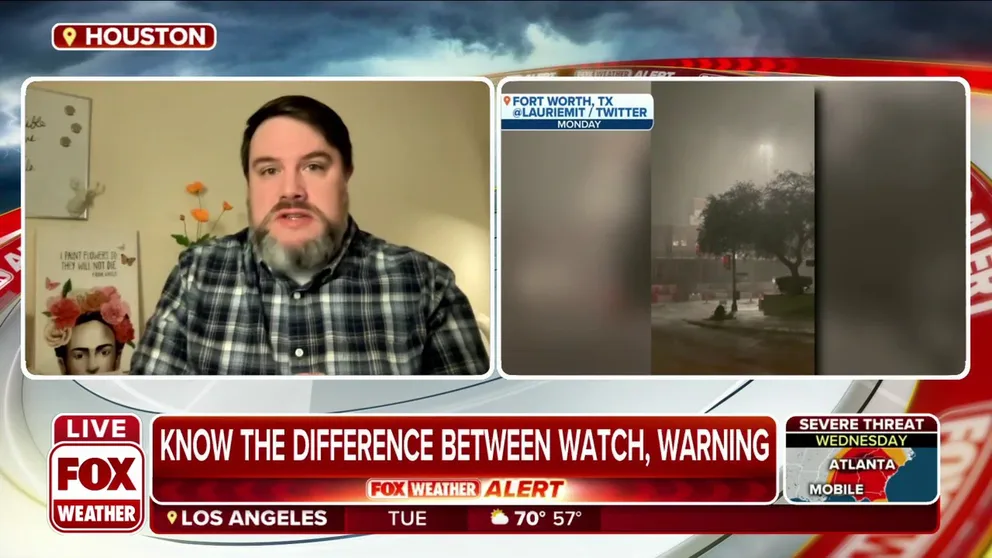Watch vs. Warning: Here are the differences between these weather terms that could save your life
Knowing these terms can help you prepare for severe weather.
What is the difference between a Tornado Watch, Tornado Warning and Tornado Emergency?
During severe weather you'll likely hear the terms Tornado Watch, Tornado Warning, and even Tornado Emergency. But what do these terms mean and how should you react to them?
When severe weather is happening, meteorologists at the National Weather Service use a variety of statements to keep you informed about the dangers you could face. Some of them are more urgent than others, and knowing the differences in each of them can help you stay safe.
The primary goal of any statement issued by the NWS is to protect life and property.
Let’s take a closer look at the terms used in these statements, starting with the least serious.
Advisory
What it means: This type of statement is issued when significant weather is happening or forecast, but no widespread impacts are expected.
What you should do: Prepare for the type of inclement weather that is indicated in the advisory.
Example: Let’s use one of the most common types of advisories you’ll hear about as an example — a wind advisory. This means that gusty winds are happening or are expected to happen soon. While there will most likely be no widespread damage from the windy weather, it could be enough to cause a few problems. When this type of advisory is issued, you might want to close your patio umbrellas and clear your yard of loose objects.
Note: The NWS plans to discontinue the use of advisories no earlier than 2024. These types of statements will be replaced with "plain language" statements that will be used to communicate the information. You can read more about this change here.
Watch vs. Warning: Here are the differences between these weather terms that could save your life
Knowing the difference between a watch and a warning can help you stay safe in the event that severe weather hits your area. FOX Weather Senior Digital Content Producer/Meteorologist Aaron Barker explains the key differences between these weather terms.
Watch
What it means: This type of statement is issued when dangerous weather is forecast to occur and widespread impacts to life and property are expected. It means forecasters believe conditions are right for severe weather to happen. You can think of this as the National Weather Service’s way of saying, "Be on the lookout for severe weather."
What you should do: Prepare for the type of severe weather that is indicated in the watch. This means reviewing your safety plans so that you are ready to take action if a warning is issued.
Example: If a Tornado Watch is issued for your area, it means forecasters believe tornadoes are possible with any storms that develop. You should review your tornado safety plan, which means knowing how to get to the lowest level of the building you are in and how to locate an interior room with no windows on that floor.
Warning
What it means: This type of statement is issued when severe weather is occurring and poses an immediate danger to life and property.

FILE - Severe Thunderstorm Warning map issued on FOX Weather broadcast on April 18, 2024.
(FOX Weather)
What you should do: Take action, meaning you should immediately execute your safety plan for the type of severe weather that is indicated in the warning.
Example: If a Tornado Warning is issued for your area, it means meteorologists have detected a possible tornado on radar or a trained storm spotter has reported seeing a tornado. You should immediately go to your storm shelter. If you don’t have a storm shelter, get to the lowest level of the building you are in and head to an interior room with no windows. The goal is to put as many walls between you and the tornado as possible. Make sure to cover your head.
Emergency
What it means: This is the most dire of all the statements that are issued by the NWS, and is usually reserved for tornadic situations. It means that there is a significant threat to human life and catastrophic damage is likely to occur. The tornado also must have been seen by a spotter or a particular type of radar signature that indicates the presence of debris in the air must have been detected.
TORNADO EMERGENCY RARELY ISSUED: WHAT IS IT?
What you should do: Take immediate action, by following your severe weather safety plan now.
Example: If a tornado emergency is issued for your area, it means meteorologists believe a large, destructive tornado is on the ground and moving toward you. Go to your storm shelter or the lowest level of the building you are in. Find an interior room with no windows and cover your head. Stay there until the storm passes.

